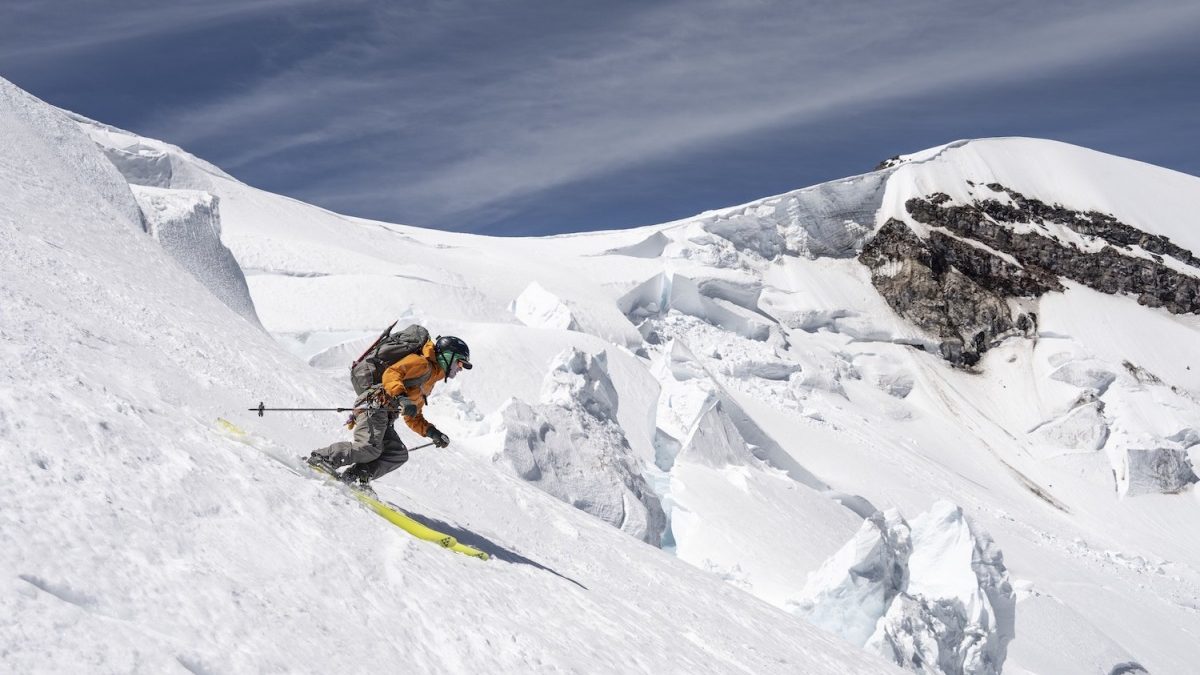
Trevor Kostanich skiing the Emmons glacier with the glacial formations of the Winthrop Glacier and Russell Cliff in the background. This skiing was captured at around 12,000’, a point at which the snow quality was excellent and the glacier was well covered. Nearly continuous skiing on this route was found from the summit all the way to Glacier Basin, a nearly 8,500’ ski run. Photo: Scott Rinckenberger
At 1 a.m. on June 24, during the start of an unprecedented heat dome that would bring three-digit temperatures to the Pacific Northwest for the week to come, two skiers set off from the Mt. Rainier Glacier Basin Trailhead. Trevor Kostanich and Scott Rinckenberger were beginning their own journey of exceptional proportions, one that would last five days and take them up and down Washington State’s five volcanoes.
The feat had been attempted before, by Kostanich and Peter Avolio in 2018, and then by Kostanich and Rinkenberger earlier in spring 2021. With a total of 42,950 feet of vertical and 90 miles of climbing, skiing and hiking to be done over 120 hours (not to mention driving from one volcano to the next, eating, sleeping), it’s the kind of endeavor where logistics, tough mental and physical fitness and the good graces of the often-fickle Washington weather gods are essential recipes for success. When Kostanich and Rinckenberger returned to Glacier Peak’s North Fork Sauk River Trailhead at 9:30pm on June 28 the celebration was well deserved.
To maximize efficiency, the duo skied all familiar routes including the Emmons glacier on Rainier, Monitor Ridge on Mount St. Helens, South Ridge on Mount Adams, Coleman Deming on Mount Baker and the North Fork Sauk to the White Chuck glacier on Glacier Peak. Wanting to get a sense of what went into the trip, I called up Rinckenberger to talk logistics, gear and the small moments that made it worth it.
WS: What an awesome accomplishment. Talk me through your logistical framework and decision making.
SR: On the previous attempt we had wanted to get into Rainier earlier on the trip but the weather wasn’t conducive. As we got a few volcanoes in I found it was mentally challenging to have Rainier looming, as it’s the most objectively hazardous and complex of the peaks. This time, it was really good to get Rainier done at the beginning of the heat wave, before it started to take its toll on the crevasses, snow bridges and seracs.
Mount St. Helens came next, which served two purposes, one being a direct commute from Rainier. It also served as a sort of rest day since it’s under 5000 feet of climbing and under 10 miles of moving, relatively relaxing in the grand scheme.
Day three was Mount Adams, mostly due to proximity to the other southern volcanoes. We went up to Baker after, because we wanted to keep Glacier Peak as the finale. Glacier turns out to be over 35 miles and 13,000 feet of climbing in a single day. We knew from experience that after doing that, it’s unlikely you have a whole lot of motivation to go out and climb another volcano. Putting Glacier Peak at the end was a way to stack the psychological deck in our favor and know that once we finished that we’d be done with the whole project.
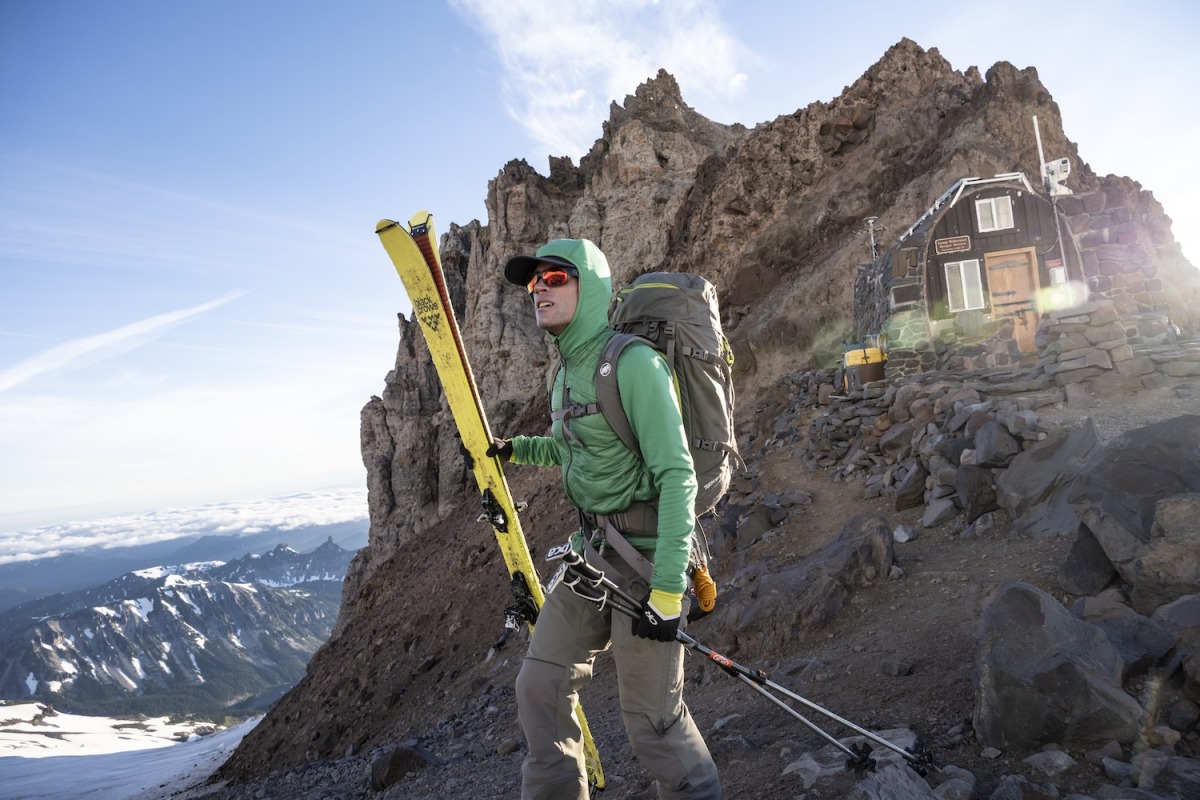
Trevor Kostanich carries his skis across the rocky ridge in front of Camp Schurman below the prominent rocks of Steamboat Prow. This point was reached at approximately 6am on day one, 5 hours after leaving the Glacier Basin trailhead near the White River campground. Camp Schruman is located at 9400’ on the NE side of Mount Rainier, and serves as the jumping off point for the Emmons / Winthrop climbing route. Photo: Scott Rinckenberger
WS: How did you manage sleeping, driving and the actual time to ski?
SR: Sleeping was the thing that got sacrificed for the most part. We tried to maximize efficiency as much as possible. We gave ourselves the day before to get down to Rainier to get permits and get set up in a place where we could crash for a few hours. We were climbing by 1 a.m., so within an hour of day one we were already on trail.
Basically the general flow would be to try to get on and off of the mountains as efficiently as possible while still maintaining a pace that was manageable over the course of the five days. Then immediately on returning to the vehicle we dump all our gear out in the parking lot to let it dry and eat as much food as possible. We handed off driving for three volcanos so one would be napping in the back and one would be driving. For the final two volcanoes we looped in a good friend of mine, Chris Shalbet and he took over the driving from Seattle to Baker and Baker to Glacier peak which gave us a few more hours of sleep time.
It was relentless in that the clock was always ticking and you’re always paying attention that every lost minute is not coming back. But we were both having fun with it.
WS: How did you prepare?
SR: Having the previous go where we did the three volcanoes — and for the record we didn’t quite summit Glacier Peak on our attempt that time — gave us a lot of mileage back to back and was good training from a fitness standpoint. Previously in the season I had taken and 80 pound pack into the Picketts, which gave the body a little taste for what was to come. Trevor is a ski guide by trade and both my work and freetime I spend a lot of time in the mountains in the winter, so we both came into it with a lot of ski touring fitness.
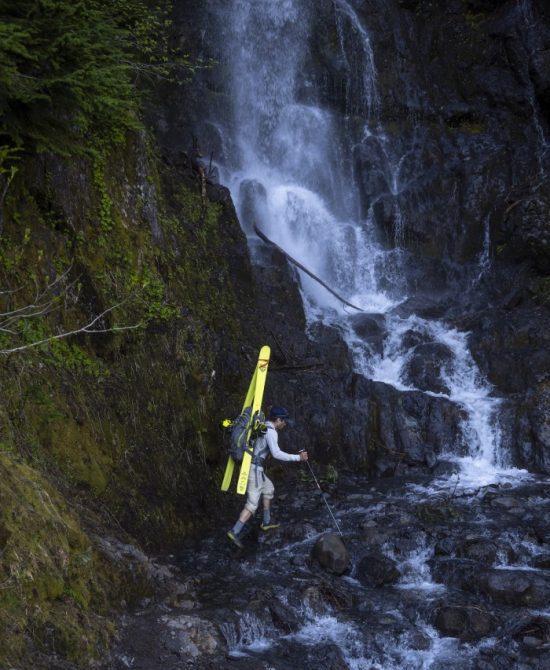
Trevor Kostanich crosses below a cascading waterfall on the Heliotrope Ridge trail during the exit from Mount Baker. Each peak required significant mileage of trail walking before skis could be employed on the glaciers and seasonal snow fields. Photo: Scott Rinckenberger
WS: What ski setups were you on?
SR: I was on a Fischer Transalp 90 with La Sportiva bindings and Salomon MTN Lab boots. So, a little heavy on the boots. If I had another pair as broken in and comfortable as the Salomons, I might’ve entertained that but wanted to not have gear problems at all.
Trevor was on Black Crows Orb skis with a Dynafit TLT binding with Scarpa Alien boots.
WS: What were some essentials that you had in your packs?
SR: Pack strategy changed on a daily basis. The gear recipe for success on Glacier Peak is different than it is on Rainier than it is on St. Helens, given the complexity and technicality of the mountains. We didn’t carry too much in terms of bivy gear because we needed to keep pack weight down as much as possible and also given the heat wave we were in, it would’ve been quite easy to survive an open bivy with the puffy jackets and beanies we carried. The temps were staying mid 40s to 50s every night so we weren’t exposed to any real cold. We always had first aid, emergency repair and communication equipment and the layering systems and technical equipment would vary. On Rainier and Glacier Peak we also brought a stove because we spent enough time above running water that we wanted to be able to melt water as needed.
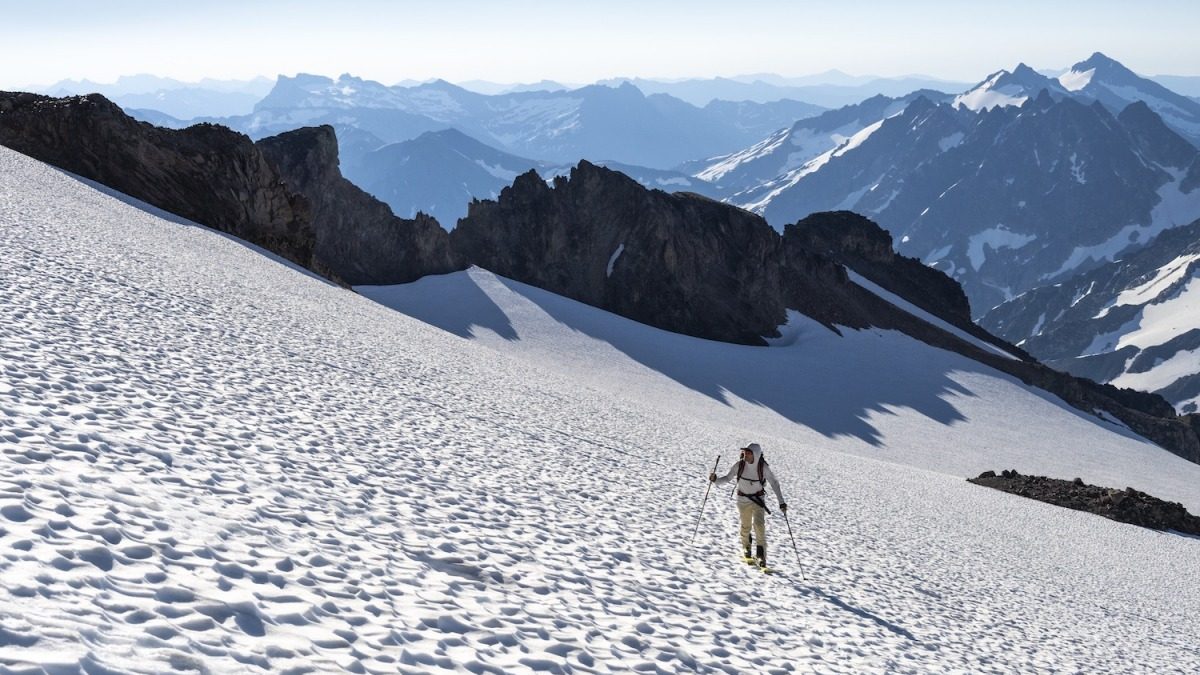
Trevor Kostanich climbing the Gerdine glacier en route to the summit of Glacier Peak. Requiring nearly 27 hours of consistent movement, Glacier Peak, the fifth and final volcano of the project, was the mental and physical crux. By starting at 6:30pm the previous evening, much of the travel was accomplished in the cool hours of night, requiring only the exit hike be executed during the record midday temperatures of the heat dome. Photo: Scott Rinckenberger
WS: Were there any particularly difficult moments?
SR: Trevor and I both hit our points of a psychological challenge on Mount Adams. We started at 10 p.m. and finished up a little bit before 9 a.m., so the vast majority of the climb happened in the dark. We weren’t expecting but found a lot of wind that night. We were just out in these giant snowfields getting absolutely blasted by wind with no daylight for hours and hours after having knocked off a couple of pretty big days previously. He and I both got to the point where we were sleep skinning. Even the summit snowfield ended up being punchy and hollow crust and really terrible snow. The way the conditions, the environment and the snow quality all lined up, we both felt a little beat down.
WS: Were there any really memorable moments where you were super psyched and realized it was going to come together?
SR: With some small exceptions, and that night on Adams being one of them, we stayed in the type one fun zone for the vast majority of the time. I think that was due to a number of things. We both came out with a really positive headspace and decided we were going to enjoy ourselves regardless of what happened and we were going to be happy to be there and thankful to have the opportunity. That paid dividends over and over. We also felt really good this time. Both of us not having succeeded in the past, we were pretty methodical in our planning and scheduling and as we went we were on or ahead of schedule every day. As that continued to be the case it built momentum in a really positive way.
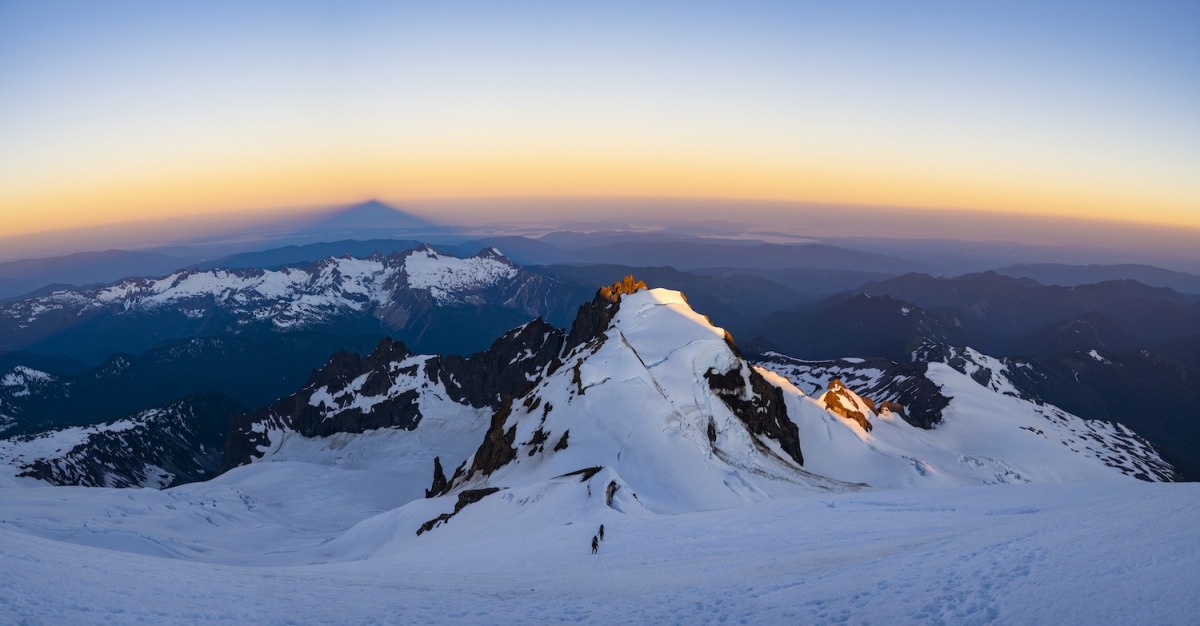
Climbing parties ascending the Roman Wall, the final steep face en route to the summit of Mount Baker, while sunrise lights Colfax Peak below and casts the shadow of Mt. Baker across the San Juan Islands and Puget Sound. Photo: Scott Rinckenberger
By the time we got to the summit of Baker on day four and it was sunrise over the North Cascades, we were looking out at the Pickett range and Mount Shuksan. It was a really beautiful morning with no wind and it was the fourth out of five, definitely in that moment it felt like everything was lining up. At that point we started really having fun.
It was pretty novel too, because generally for the volcanoes the standard schedule is you want to set yourself up for the perfect corn. More times than not it means you’re going to try and ski sometime between 10 and 2 or something like that. For this, since the temperatures were so anomalous, we pretty much skewed everything to spend as much time working in the dark as possible to stay out of the heat and keep out of dangerous snow conditions. All of the climbs were full night projects. For the most part we were arriving at the summit right around sunrise every day so they were all really beautiful experiences.
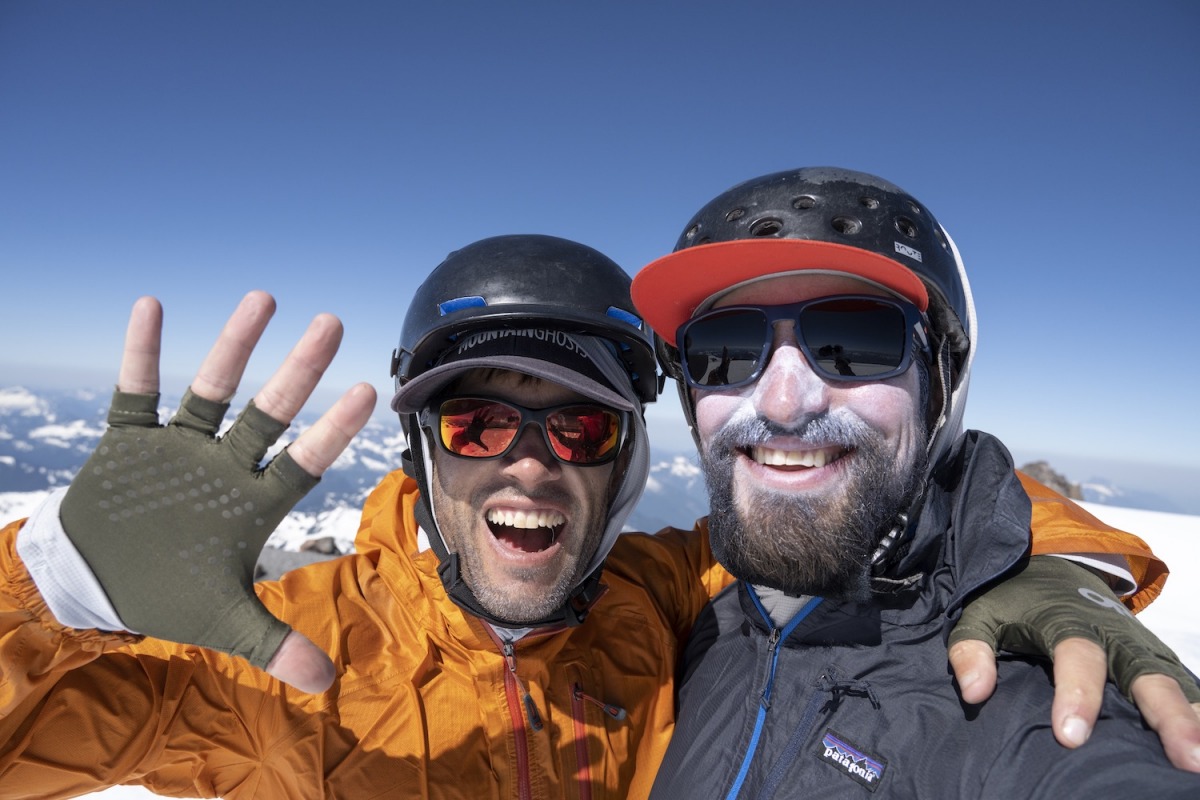
Trevor Kostanich (left) and Scott Rinckenberger (right) celebrate their 5th volcano summit in 5 days on the top of Glacier Peak. The most remote, and most pristine of the Washington volcanoes, Glacier Peak would prove a significant test, but would also provide a spectacular wilderness experience, and a fitting adventure to end the journey. All told, the round trip to the summit of Glacier peak included 36.6 miles and 13,140’ of elevation. The team would arrive at the North Fork Sauk trailhead at 9:25pm, which put them just a few hours ahead of their self imposed midnight deadline for completing the 5 in 5. Photo: Scott Rinckenberger
For more photos and stories, follow @scottrinck and @trevorkostanisch and check out Scott Rinckenberger Photography
Manasseh Franklin is a writer, editor and big fan of walking uphill. She has an MFA in creative nonfiction and environment and natural resources from the University of Wyoming and especially enjoys writing about glaciers. Find her other work in Alpinist, Adventure Journal, Rock and Ice, Aspen Sojourner, AFAR, Trail Runner and Western Confluence.
